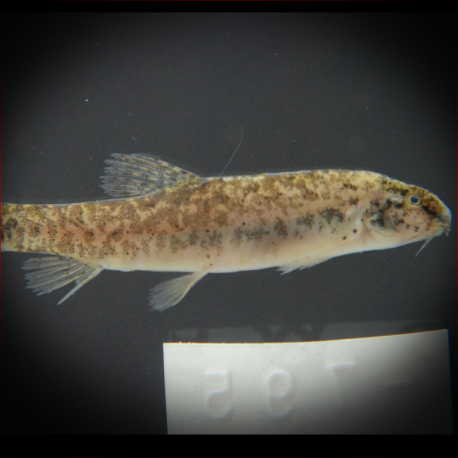More info
Datasheet
| Minimum Tank Size | 60 litres / 15.85 US gallons |
| Maximum Size | 4.5cm / 1.77inches |
| Temperature | 23°C / 73.40°F - 26°C / 78.80°F |
| Hardness | 2.02dgH / 36ppm - 10.03dgH / 179ppm |
| pH | 5.5-7.5 |
General Description
The Lepidocephalichthys Kranos, a member of the Cobitidae family, boasts a distinctive color pattern compared to its genus counterparts, featuring a mosaic pattern rather than irregular spotting. It can be identified by several unique characteristics, such as large exposed scales on the head, a slightly emarginate dorsal fin, and a "hunched" appearance due to its body depth sharply increasing from snout to pectoral fin origin. This species typically displays a thin, dark, broken lateral stripe in both sexes, with males showcasing a dorsally-oriented flange-like projection called lamina circularis.
Aquarium Setup
Setting up an aquarium for Lepidocephalichthys Kranos is relatively simple. It requires a soft, sandy substrate to accommodate its burrowing behavior. Incorporating water-worn rocks, driftwood branches, and tree roots can provide hiding spots and shaded areas. Dim lighting is suitable unless you plan to grow plants. Maintaining a low flow rate is essential, and precautionary measures should be taken to prevent small specimens from entering filter intakes.
Behaviour
Lepidocephalichthys Kranos is a peaceful species that coexists well with conspecifics and other fish species in a community tank. These fish thrive when kept in groups of four or more. They feel more secure in the presence of upper-water column dwelling fish like certain Danio species. Additionally, they are known to exhibit timid behavior when not in the company of such fish, as the absence of upper-level swimmers might indicate potential danger.
Feeding and Diet
As micropredators, Lepidocephalichthys Kranos feed by sifting mouthfuls of substrate and extracting insect larvae and small crustaceans. In captivity, they accept sinking dried foods but should also be regularly offered live or frozen fare like Daphnia, Artemia, and bloodworms to meet their nutritional needs.
Reproduction & Dimorphism
While the reproductive behavior of Lepidocephalichthys Kranos is presumed to be seasonal in the wild, successful breeding in captivity has not been documented. In terms of sexual dimorphism, mature males exhibit enlarged pectoral fins with a unique structure called lamina circularis, formed by fused innermost rays. Adult females are generally larger and heavier-bodied than males, with spotted patterning on the flanks as opposed to a dark stripe.
Habitat and Distribution
The natural habitat of Lepidocephalichthys Kranos includes shallow, slow-moving streams, swamps, oxbows, and paddy fields with soft mud or silt substrates. These fish are commonly found in heavily vegetated or root-laden areas. They are extensively distributed throughout the Chao Phraya river system in Thailand and parts of Laos and Vietnam. The species demonstrate adaptability to varying water conditions, including periods of hypoxia where some individuals can gulp atmospheric air to survive.
Please note that this content is a summary and rewrite of the provided information.

